GYLON EPIX® is a newly developed family of PTFE gaskets. It is manufactured using a patented, profiled surface based on our proven Fawn, Off-White, and Blue GYLON® to create highly conformable materials for optimum sealing performance.
GYLON EPIX® will provide superior functional performance by combining the traditional attributes of GYLON® with an innovative surface design. It offers a broader range of applications than traditional PTFE gaskets that are used in worn and pitted flanges. In addition, GYLON EPIX® delivers the tight sealing and load retention properties of 1/16” (1.6mm) and the conformability of 1/8” (3.2mm). The hexagonal profile provides improved compressibility and recovery. The profiled surface reduces the contact area during initial compression to concentrate the compressive force of the flange for improved sealability.
Designed for increased compressibility, GYLON EPIX® improves performance in misaligned flanges. The consolidation of two thicknesses to one reduces the need to inventory multiple thicknesses. Garlock is dedicated to providing real sealing solutions that meet real world sealing needs. With an improved design, color-coded materials, and single thickness, GYLON EPIX® makes sealing easier.

GYLON EPIX® Style 3500 Gaskets – PTFE with Silica Filler
PTFE with silica filler gaskets for use with strong acids, solvents, water, and other aggressive media.

GYLON EPIX® Style 3504 Gaskets- PTFE with Aluminosilicate Microspheres
PTFE gaskets with aluminosilicate microspheres for use in many acids, solvents, hydrocarbons, refrigerants, and more.

GYLON EPIX® Style 3510 Gaskets – PTFE with Barium Sulfate
PTFE gaskets with barium sulfate filler for use in strong caustics and moderate acids where an extremely tight seal is critical.
At Flexaust, we are a supplier of durable and reliable hose for industrial and commercial applications. Our hose offerings include polyvinyl chloride (PVC) hoses, thermoplastic rubber (TPR) hoses, and polyurethane (PU) hoses, all of which demonstrate different temperature range, abrasion resistance, and wall thickness requirements that make them a good, better, and best fit for different applications. In the following article, we discuss these three hose options and the applications for which they are best suited.
How to Choose the Right Hose Material
When selecting a hose material for a particular application, it is important to consider its performance in the short-term and long-term. For example, the ideal material should accommodate the environmental and operating conditions (e.g. heat, extreme cold, etc.) now and in the future. Below we outline how PVC, TPR, and PU measure up in these capacities.
PVC Hose: The Good Option
PVC hoses are an economical option for general-purpose applications. They are typically used in ventilation, woodworking, and other operations that do not involve exposure to extreme temperatures, chemicals, UV radiation, or abrasive materials.
Thermoplastic Rubber (TPR) Hose: The Better Option
Compared to PVC hoses, TPR hoses offer greater abrasion resistance and smoother interior assuring minimal friction loss and efficient airflow. They are suitable for use in applications that involve low or high temperatures, chemicals, moisture, and outdoor use (UV exposure).
Polyurethane (PU) Hose: The Best Option
Compared to PVC and TPR hoses, PU hoses serve as a superior solution for a wide range of industrial and commercial applications. In addition to being the most versatile hose because of its manufacturing capabilities–Flexaust has the ability to manufacture five wall thickness and static dissipative hose versions–PU hoses have great abrasion and chemical resistance, higher tear strength, better vacuum and pressure ratings, and good flexibility in low temperatures.
Common Applications of the PVC, TPR, and PU Hoses at Flexaust
Our hoses are suitable for many industrial and commercial applications. Below we outline some of the operations in which our hoses are regularly utilized for and which PVC, TPR, and PU hoses are viable options.
Woodworking
For woodworking applications, we recommend the following hoses:
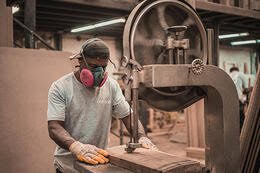
- A good option:R-4
- A better option: T-7
- The best option: Flx-Thane MD
Compared to R-4 and T-7, Flx-Thane MD offers good compressibility and superior abrasion resistance to handle anything from dust collection to larger more abrasive woodchips. The clear version is manufactured with FDA acceptable materials and is easy to detect any blockages in the hose while in service. Flx-Thane MD is also available in metric sizes, so it is compatible with European equipment.
Plastic Manufacturing (Blown Film Manufacturing)
For plastic manufacturing applications, we recommend the following hoses:
While CWGP (made from double-ply neoprene coated polyester fabric) and T-7 (made from thermoplastic rubber) offer good performance in these operations, T-7SR provides even better performance and a higher temperature range which can be critical in this application depending on equipment used.
These thermoplastic rubber-coated woven polyester fabric hoses are reinforced with a spring steel wire helix offering better tensile strength and puncture resistance than traditional reinforced woven neoprene and TPR hoses. T-7SR demonstrates superior chemical, moisture, temperature, and UV resistance, as well as suitability for demanding positive and negative pressure environments.
Street Sweeping
For street sweeping applications, we recommend the following hoses:
- A good option: HT
- A better option: Flx-Thane MD
- The best option: Flx-Thane HD
While street sweeping equipment can operate with HT or Flx-Thane MD, Flx-Thane HD is ideal. The .045” wall thickness is heavier than HT and Flx-Thane MD making it a great choice for severe service applications like street sweeping. It has better puncture resistance and excellent flexibility, all of which are important in applications involving constant movement.
Leaf Collection
For leaf collection applications, we recommend the following hoses:

- A good option: LCDC
- A better option: HT-W
- The best option: Flx-Thane HD
LCDC and HT-W are good options for leaf collection equipment. LCDC is a medium weight economical truck loader vacuum hose offering a long flex life, while HT-W has a heavier wall thickness and great moisture and UV resistance – also ideal for commercial landscaping. However, Flx-Thane HD is even better. It offers superior abrasion resistance, tear strength, and great moisture and UV resistance making it the best option.
Confined Space Ventilation
For confined space ventilation applications, we recommend the following hoses:
FX-400 is the superior solution here. It handles a wider temperature range which is critical when used for commercial and residential work area heating, cement drying, and event tents. The high strength sewn construction of FX-400 allows for better performance in low and high temperatures.
What Makes Up a Flexible Metal Hose?
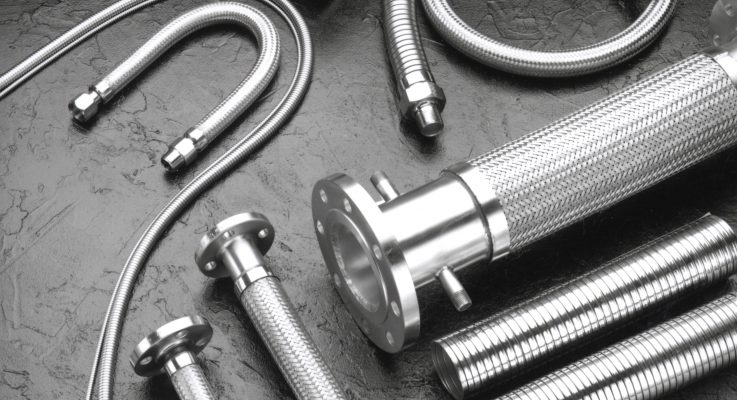
In order to understand flexible metal hose assemblies and how they serve various applications it’s best to review their anatomy. In its simplest form, a metal hose is made of four basic components:
- Corrugated tubing
- Braid
- Braid collars
- End-fittings
Separately, these parts are really quite simple. However, they can be customized to form a variety of configurations, enabling flexible metal hoses to be an optimal solution in a number of industries. Let’s examine each of these components individually and discuss how they all work together to create value.

Corrugated Tubing
The corrugated tubing is the core component of a flexible metal hose. Not only does it comprise the bulk of an assembly, but it also plays a part in key value-added attributes of the assembly, such as corrosion resistance, pressure rating, and flexibility.
Corrosion Resistance
Corrosion resistance is simply a matter of selecting the correct alloy for the media that is being conveyed. For most applications, 321 stainless steel provides sufficient corrosion resistance. If additional chemical resistance is needed, 316 stainless steel can be used, which contains more nickel and other alloying elements to increase chemical resistance. Chlorine transfer applications require the highest degree of corrosion resistance. For chlorine and other highly-critical applications, C276 may be the best choice.
Pressure Rating
Pressure rating (also referred to as “maximum allowable working pressure” or “MAWP”) is the term use to express the ability of a hose to handle internal pressure. At Hose Master, the pressure ratings of our hose is determined by conducting various pressure testing in our in-house Product Analysis Lab.
The pressure rating that “creates value” for an assembly depends on the application in which the assembly is going to be used. For many standard applications, a hose with a lower pressure rating can be used, whereas more critical applications may demand the use of a hose that can withstand higher pressures.
Flexibility
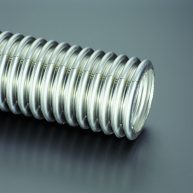
Flexibility can mean different things to different people. To some, it may refer to a hose’s ability to be bent into a tight radius. To others, it may mean a hose has a high cycle life. Or, it may mean that a hose will bend easily without exerting high spring forces on the surrounding equipment. Fortunately, there is some flexibility allowed in this definition thanks to Hose Master’s proprietary forming processes, which create metal hose that provides all three of these qualities.
For corrugated metal hose, flexibility is expressed by the “minimum dynamic bend radius” (MDBR), which is derived through testing in our in-house lab. Depending on the application, a larger MDBR may be acceptable or a tighter MDBR may be required. If an application requires a tighter MDBR, then a close-pitched hose would provide a valuable solution. Close-pitched hoses feature more corrugations per foot than standard hose, which distributes the bending stresses over more corrugations and allows the hose to be bent more tightly.
Braid
The second component of metal hoses is the braid. Along with hose selection, the braid contributes to an assembly’s ability to withstand high pressures.
There are multiple factors that can contribute to the functionality of the braid, such as the wire diameter, the number of wires per carrier, the number of carriers on the braiding machine and the percentage of braid coverage. The pressure rating of a hose may also be increased by adding additional layers of braid or using braided braid. Proper braid design has a significant effect on the working pressure and cycle life of the hose. Utilizing a braid package with a high-percentage braid coverage that is braided directly onto the hose helps to ensure that the braid is well-secured on the hose, protecting the assembly from potential deformation and ensuring maximum cycle life.
Braid Collars
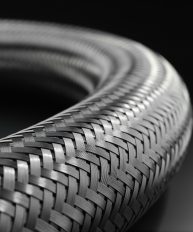
While only accounting for a small portion of a hose assembly, the braid collars have an important role. Braid collars serve to join the inner corrugated hose and the braid together during the cap welding process, in which a TIG weld joins the hose, braid and braid collar together into the cap weld bead. This cap weld needs to be perfect, as it will be the base for the subsequent attachment weld and is the connection point holding all of the components of the hose together.
Along with helping join the hose components together, the braid collars also serve to protect and isolate the corrugations near the cap weld from any movement. After the cap welding process, these corrugations are now a “heat-affected zone” and are thus unable to functionally cycle with the rest of the hose. The braid collars ensure that any bending stresses are properly distributed over the right corrugations, preserving the cycle life of the assembly.
End-Fittings

The final component added to an assembly is the fittings. There are a lot of options available when it comes to fittings selections, allowing flexible metal hose assemblies to be customized to fit into a variety of applications. Therefore, it is important that the fittings selected fit the needs of the application. Be sure to verify the size, alloy, and pressure requirements of an application before making a definitive fittings selection.
Designing a Flexible Metal Hose Assembly: Creating Value
Ultimately, what creates value for a flexible metal hose assembly comes down to the specific demands of each application. No matter the complexity, Hose Master’s skilled engineering staff and dedicated customer support personnel are able to supply not only exceptional quality in each assembly, but stellar service, resulting in the greatest value for our customers. For more information on Hose Master’s solutions contact us at (216)-481-2020 or visit us online and we’d be happy to assist you.
Copyright 2020, Hose Master, LLC
All Rights Reserved
Anyone who works in the hydraulic industry knows the importance of reducing contamination. Particles, dirt, debris and even water that enter a system can quickly wreak havoc, causing system failure and even possibly destroying a component or machine. This is why it is essential to keep these contaminants out.
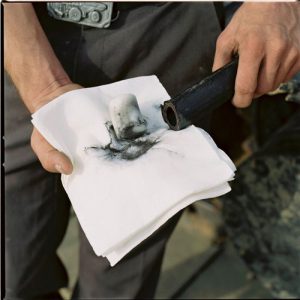
Even hose that looks clean can have plenty of dirt and contaminants inside.To ensure hydraulic fluid remains contaminant free, it is imperative to clean all new hoses before installation. If contaminants are left in a hose after it has been shipped to a user or has been cut and crimped, those rubber and dirt particles will easily end up in the reservoir and flow throughout the entire system.
Three common methods are used to remove contaminants from the inner tube of a hydraulic hose: high-pressure air, fluid flushing and projectiles.
Air — High-pressure air can be blown through a hydraulic hose or assembly, as long as it is clean and dry. This works best with shorter, smaller hoses, as the longer the hose, the more likely particles may get caught within the assembly.
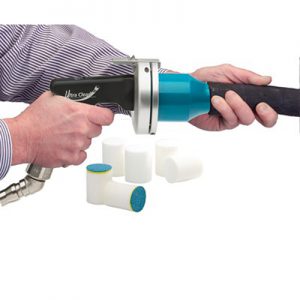
Shooting foam projectiles through hydraulic hose assemblies ensures dirt and debris is effectively removed. Image courtesy of Ultra Clean Technologies Corp.
Fluid flushing — As long as the fluid is clean and compatible with the hose assembly’s inner tube, you can flush an assembly with high-pressure fluids to create turbulent flow. This will remove contaminants from the inner tube wall. However, to ensure the fluid is clean itself, you must use filtration to ensure that the fluid itself is contaminant free. Before you can install the hose, you must ensure that the inside of the hose is then dry.
Projectiles — Perhaps one of the most effective methods is through the use foam projectiles that are shot through a hose assembly via dry compressed air or another inert clean gas. Special hand-held or bench-top launchers should be used to ensure the projectile travels completely through the tube and is not left behind inside the hose. The projectiles must be approximately 20 to 30% larger than the ID of the hose tube, as they compress against the wall of the hose assembly to “grab” any dirt and debris.
As the foam projectile travels quickly through the assembly, it picks up any dust, debris and particles and gives the user a visual look at how much contaminants it has removed. It is recommended to use these foam projectiles from both ends of the hose assembly, and then to cap the ends to ensure they remain contaminant free.

It comes as no surprise that metal corrugated hose is the preferred choice for high-temperature applications. But what about low-temperature applications? This is a question we frequently see from our customers. The simple answer is yes- metal hose is a great option for low-temperature applications. However, there are important factors that should be considered before making a recommendation.
Service Conditions
Before recommending a particular hose for a low-temperature application, we first need to identify the conditions that the hose will experience while in service. For example, what are the minimum and maximum temperatures of the application? If the assembly is going to be exposed to wide temperature variances, it is important to determine how frequently and rapidly the temperature will change. Metals expand and contract as they heat and cool, and at different rates depending on the alloy. Severe fluctuations in operating temperature can apply stress on welded joints as the base materials expand and contract, which may cause cracks to form.

A traced assembly can be used to regulate media temperature.
One way to verify that an assembly will be able to accommodate these stresses safely is by conducting a cold shock test. Cold shock (or “thermal shock”) testing is performed by plunging an assembly into a cryogenic bath, then allowing it to return to room temperature (or to the highest temperature to which it will be exposed), followed by various testing and inspection. This ensures that the welds will not crack when exposed to similar temperature extremes while in service.
Another service condition to identify is whether the temperature extremes will be present inside the hose (the media temperature) or outside the hose (the external environment). Will the hose be buried in ice? Will it have cryogenic liquids flowing through it? Is there a chance the media could freeze and change into a solid? Is it possible for frost to build-up on the hose exterior? These are all potentially damaging conditions that can be mitigated by selecting the correct assembly for the job. For example, an application in which the hose may surrounded by a cold exterior environment may be best served by utilizing a traced assembly. We recommend using the STAMPED acronym to assist you in identifying the service conditions for any hose application!
Standards and Certifications
“The simple answer is yes – metal hose is a great option for low-temperature applications.”
Along with service conditions, it is important to also identify any standards that must be met in an application. This can be a challenge because there are different standards that may apply depending on the alloy, the forming process (cast, forged, drawn, etc.) and the finished product (hose, pipe, flanges, etc.). Hose Master uses the low temperature ratings in the ASME Process Piping Code B31.3, as well as other internationally recognized standards. Identifying the applicable standard is important because different standards may have different low temperature ratings for the same alloy.
When identifying standards, it is also important to note that a particular alloy may have multiple certifications, meaning it complies with two (or more) standards, each of which may offer different ratings for a given alloy. For example, many of our alloys comply with both ASTM and EN (European) specifications. In these instances, the standard specified by the customer dictates the minimum allowable temperature rating.
Finally, the method of fabrication may affect the allowable low temperature limits. Many standards include or make reference to various welding requirements, many of which require the welders to achieve and maintain compliance to those standards through thorough education, testing, and audits. These standards may dictate the allowable low-temperature limits for a welder’s certification, superseding the low-temperature limits of the materials being joined.
Selecting a Metal Hose for Your Low-Temperature Application
In summary, there is no one answer to “how low you can go” in regard to operating temperatures for metal hose. Finding out as much as possible about the intended application, including any applicable standards, ensures not only that the materials of the assembly will be able to handle the application, but also that the assembly will conform to any required specifications. If you have any questions regarding the conditions and standards involved in your low-temperature applications, please contact us and we would be happy to help you!
Article from:

Eaton introduces the Synflex Optimum thermoplastic hydraulic hose and fitting product line empowering OEMs to reimagine design without limitation. Our system engineered portfolio offers streamlined product configurations for simplified selling across numerous applications with improved hydraulic system performance to your customers while optimizing your inventory!
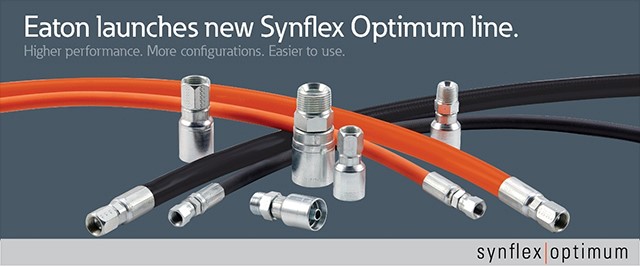
Benefits of new 3TR Synflex Optimum Hose:
- Nonstick cover reduces routing force requirements
- Reformulated cover improves abrasion resistance
- Innovative tube compound improves chemical resistance
- Innovative tube compound improves cold temp flexibility
- Better adhesion level improves kink resistance
- Twin-line (multi-line) bonding capability
- Thermoforming for low cost, leak free and quick drop-in assembly
Benefits of new 4TA Synflex Optimum Fittings:
- Reduced insertion force to push fitting onto hose
- Leverages existing crimp machines and tooling
- Single piece design eliminates brazing failure risks
- Captive nut evenly distributes force during assembly
- Leverages 1A nipple to unlock 500+ terminal end connections
- Smaller profile for improved routing capability
- Part number marking for easy identification
- Dura-KoteTM plating for extended corrosion protection
- Works with all Synflex Optimum hose series
Originally developed by Flexitallic in direct response to customers’ long-term heat exchanger sealing problems. Change™ is a highly-resilient metal-wound gasket, designed to deliver the most dynamic static sealing technology ever. Manufactured using proprietary equipment, Change™ has a proven track-record showing it outperforms conventional gasket technology in challenging environments, especially in applications with mechanical and thermal cycling conditions. It has also achieved independent industry accreditation from TA Luft for its ability to deliver the tightness of a Kammprofile with the recovery of a Spiral Wound Gasket. This is achieved through the application of a unique metal spiral profile, which is more advanced than those found in standard gaskets. This profile, combined with a laser welding process, facilitates the construction of a robust and dynamic seal.
What is the difference between wire braid and spiral hydraulic hose?
The fluid power industry takes common knowledge for granted, but we often forget every single individual in the industry was once a beginner, not knowing of the basics. The quest for knowledge starts with the basics, and what is more basic than knowing the difference between two fundamental hydraulic hose construction types.
What is the difference between wire braid and spiral wound hydraulic hose? This is a common and fair question. Both wire braid and spiral wound wire perform the same task. However, there are slight variations.
A wire braided hose consists of crossing and woven high tensile steel wires overlapping one another to reinforce the tube below. Wire braiding machines perform a complex task of winding the wire intricately around the tube, like dancers around a horizontal maypole. The overlapping nature of braided wire not only increases burst resistance to the tube but also allows flexibility between the braids. The crisscrossing braided wire has more tensile play than a spiral hose, resulting in tighter bend radius and overall flexibility.
A spiral wound hose consists of two or more sets of helically wrapped high-tensile wire that exhibits excellent strength, making the hose very strong and very rigid. The resistance to pressure spikes is remarkably high, especially when compared to a braided hose. However, the bend radius suffers, and spiral wound hose is highly resistant to bending. This effect is especially evident with 4- or 6-wire hoses, which are required from many large diameter, high-pressure applications.

Which to choose will depend on your application. Although technology advances are improving the strength of braided hose, other technological advancements are improving the flexibility of spiral wound hose. The hose industry is highly competitive and ever changing, so you can expect improvements in both construction types as materials and manufacturing.
Article courtesy of hoseassemblytips.com
F.B Wright is a distributor and fabricator for McAllister Mills products, including their electric heated blankets/jackets. Winter has finally arrived, and with temperatures in the single digits, it’s important to protect high temperature textiles and applications. These blankets provide freeze protection, process control and stability throughout the winter. All of these electrically heated jackets are produced under one roof in the USA to deliver you quality at a value. For more details or information, please contact us!
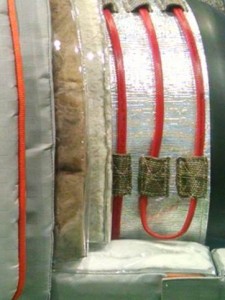
At FB Wright, we manufacture and assemble hoses. A unique example of this are the hoses created by Aflex that we assemble. They are used for tough chemical and pharmaceutical applications. We detail these hoses below, and offer further detail via links to Aflex’s website. If you’d like to inquire about them, please contact FB Wright.
Innovation not imitation!
Aflex Hose Ltd
The world-wide leading innovators of PTFE hose technologies are proud to share with you our newest and most diverse range to date.
• Bioflex Ultra is our ultimate PTFE hose which features a smoothbore inner and convoluted outer patented design, this allows for clean, non turbulent flow while ensuring a high level of flexibility and kink resistance. Bioflex ultra can also offer temperature limits of; -100°F (-73°C) to +500°F (+260°C) on certain specifications of hose. There are many different covers available to be added onto Bioflex Ultra including our fireproof and antistatic EPDM rubber covers. This product is available to purchase in many different sizes and offers full vacuum resistance in any size.
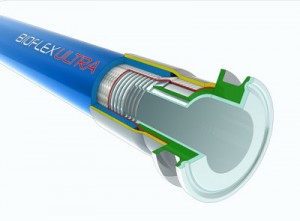
• Corroline+ has been developed to meet all of the rigorous requirements of today’s chemical production processes while still ensuring our high levels of flexibility, Crush and kink resistance are upheld. Corroline+ is highly durable due to the smoothbore inner and convoluted outer design, This also makes this product fast flowing and easy to clean. Corroline+ has a wide temperature range from -40°F (-40°C) up to +284°F (+140°C) continuous. Corroline+ comes complete with a black EPDM rubber cover which is both antistatic and fireproof.
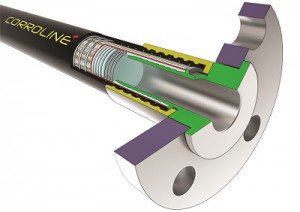
• Pharmaline is our high
purity and kink resistant hose range which makes them ideal for use in the pharmaceutical or biotech industries or where total chemical resistance is required. Our range includes the Pharmaline X and Pharmaline N products. Both Our Pharmaline products have a smoothbore inner and convoluted outer design. They are completed with a platinum cured silicone outer cover. Pharmaline has a temperature range of -100°F (-73°C) up to +400°F (+204°C).
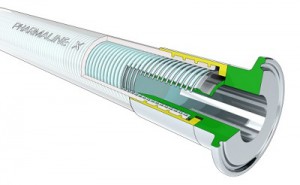
• Corroflon has been designed with a shallow convoluted PTFE liner tube to ensure it remains very tough, exceptionally flexible and fully kink resistant. Corroflon has a wide bore size range – up to 6” (150mm) and can feature a temperature range of -100°F (73°C) to +500°F (260°) when a stainless steel braid is applied. Corroflon as standard comes with a stainless steel or polypropylene braid with Hastelloy or PVDF braids available to special order. Black EPDM rubber or clear silicone cover are the external cover options.
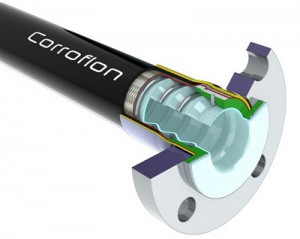
All of our products are manufactured and assembled in our state of the art facility and these products allow us to offer a suitable commodity to cover any industry requirement. We also offer a wide range of end fittings from cam & groove fittings to Swivel flange fittings.
Every product in our range will come with full certifications as standard, these include ISO 9001, EN12115, TS16949, and FDA.
